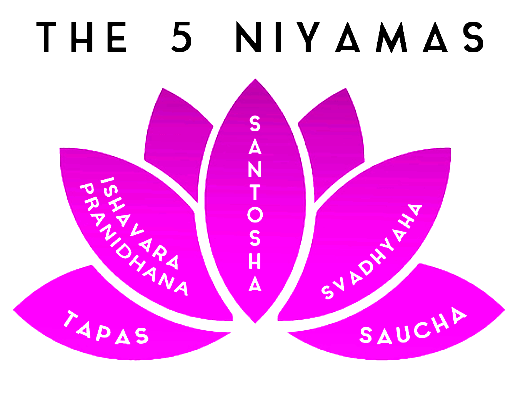Niyamas are the second limb of Ashtanga Yoga, the eightfold yogic path. According to Maharishi Patanjali, the spiritual path of a sadhaka or spiritual seeker consists of eight limbs: Yama, Niyama, Asana, Pranayama, Pratyahara, Dharana, Dhyana, and Samadhi
Yoga asana, pranayama, and dhyana practices are incomplete without following the Yamas and niyamas.
We have already learned in detail about Yamas in our previous post. Now let us understand what the niyamas are, their importance, and how to follow them ethically.
Just as the Yamas guide how to interact with the world around us, the Niyamas offer guidance on how to relate to ourselves.
The five Niyamas are:
- Saucha
- Santosha
- Tapas
- Svadhyaya
- Isvara Pranidhana

Saucha
Saucha is the cleanliness of the body, mind and intellect.
The Saucha of the body has to be both external and internal. A devoted seeker should
- Keep his physical body clean by practising shat kriyas such as kapalbhati and Jal Neti, along with regular bathing, followed by Yoga Asanas.
- Eat Sattvic and vegetarian food, to enhance the subtle energies nourishing the inner body.
- Keep the body hydrated, by drinking ample water and fluids.
The seeker then progresses with complete Saucha – Manasa, vaacha and karmana:
Manasa Saucha (of Thoughts) starts with pure and clean thoughts. Be aware of what you read, watch and absorb from people, TV and social media.
Vaachaa Saucha (of Words) is practiced by being mindful of what you speak. Each word should be genuine, soft, sweet, truthful and compassionate (with Ahimsa). Be conscious of the kind of conversation you indulge in.
Karmanaa Sucha (of Action)- When you interact with people, there is an exchange of energy. This energy should be clean and positive. Walk away from people and places where there is negative energy(such as gossip) or unwanted conversation.
Santosha- the second Niyama
Santosha, the second niyama, means contentment.
All our happiness is routed through the outer world; through possessions, people, situations and the achievements of the physical world.
We make so much effort for this happiness, but the result is not in our hands. When they are favourable, we are happy and proud. On the contrary, we blame it on others or on God.
Santosha starts by understanding that everything in life is just a ”HAPPENING”. If we do our best in every ‘happening’, without the expectation of any desired result, we are able to accept the outcome, with equanimity and contentment.
Santosha depends on our inner state of mind and our subtle intentions while dealing with the world.
What to do for true inner contentment or Santosha?
- Trust in the power of the Universe and ‘let go’.
- Observe and understand yourself, by being in sakshi bhava (witness mode).
- Practice Yamas (Ahimsa, Satya, Asteya, Brahmacharya and Aparigraha) in Manasa, Vaachaa and Karmanaa.
- Be true to yourself and trust yourself.
- Never hurt anyone, in any way.
- Always smile through all types of ‘happenings’.
- Connect with nature.
A true yogi is said to be in santosha when his inner state is of pure love.
Tapas- the third of the Niyamas
Tapas means self-discipline.
The word tapas comes from the root Sanskrit verb ‘tap’ ( तप ), meaning ‘to burn’ or to heat. Here, it implies doing things consciously with awareness, a fiery passion and discipline. It also means doing things which are beneficial for your spiritual progress and inner well-being.
How do we practice Tapas?
Tapas is an intense inner purification process which has to be worked upon in three ways:
Manasa tapas (of mind) is done by silencing the mind with the dedicated everyday practice of meditation. Bring down the inner chatter and make it quiet. Break down the barriers of your own belief systems. Make the mind flexible.
Vaacha tapas (of Words) is observing and understanding the quality of your own
“Vaakshetra” moment to moment. Keep observing what you speak, how you speak, where you speak, and how others respond to your words.
Karmana tapas (of Actions) involves passionately desiring and being disciplined about doing everything that needs to be done, for inner well-being – reading, journaling, the practice of Shat Karmas, Yogasana, Pranayama and Meditation. Doing all this within the constraints of your daily life is tapas.
Only then can a seeker reach the atma or the Soul and open up its intuitive plane for Divine guidance.
Svadhyaya
स्वाध्याय
Literally, it means reflecting on self or contemplation.
In Sanskrit, Sva means self and adhyaya means study. In simple words, svadhyaya is the study of the self. Svadhyaya is the fourth Niyanma.
Your spiritual journey is all about understanding and finding the self. In the stillness and silence of your mind, you are able to meet your own self. Your goal is to reign your mind.
How to do svadhyaya or self-study?
Patanjali’s Yoga Sutra says: “Study thyself, discover the divine”

- Meditation/Dhyana: Being focused on the breath quietens the mind. As the mind becomes calm and silent, you are able to journey within. Make meditation lifestyle.
2. Sakshi Bhaav: Witness yourself as a third person. From moment to moment, observe every thought, emotion, word and action of yours, to understand the self.
3. Being with the Self: Start enjoying the “me” time by just sitting quietly, observing and starting to love one’s inner presence. In time “self-love” will develop.
4. Journaling: Write a diary daily about your experiences, feelings/thoughts on how and what could have been different in your behaviour. It gives tremendous clarity about the self and food for contemplation.

5. Reading: Read scriptures, spiritual books, or life and works of wise ones who traversed the path to brahman, gave deeper insights, varied perspectives on the subject of the self. The Bhagavad Gita, Ashtavakra Gita and Yoga Vasistha, are very profound manuals in this journey. Make reading a daily habit.
6. Mentoring: Teaching and sharing your understanding and knowledge with others, solidifies it deeply within you. Your conviction of what you know becomes stronger and multiplies manifold.
Ishvara Pranidhana
īśvara (ईश्वर) – means God,
praṇidhāna (प्रणिधान) -means Surrender
The fifth of the Niyamas – Ishvarapranidhana keeps you rooted to your purpose and connected to the source throughout the day. It brings sacredness to your purpose. It can be as simple as lighting a diya or chanting a mantra or paying salutations to the morning Sun before your Meditation or any other spiritual practice. In simple words, it means surrendering every deed to the supreme.
It makes one feel that one is on the spiritual path. By bringing this feeling, one surrenders oneself to the higher being within.
How to practice Ishvarapranidhana?
- Let go and be with the flow of life
- Move from ‘I and Me’ to WE, polish the sharp edges of the personality
- Become soft and subtle and fluid in thoughts, words and actions
- Dissolve the separateness between the outer personality self and the true inner self
- Operate from the space of inner intuition rather than intellect
Practising Ishvarapranidhana leads to merging with the true self, remembering your Godhood and becoming one with the divinity within.
By surrendering to the Ultimate Inner Consciousness we build the trust that we are taken care of by the Universe and that everything works in our best interest. We not only surrender our ego but also all our deeds or karma, with no attachment or worry about the outcome.
Summarizing it..
In our previous post we learnt about the first step we need to take- following the Yamas. The 5 yamas of Ahimsa, Satya, Asteya, Brahmacharya and Aparigraha teach us about outer or social behaviour. Now we learnt about the 2nd step for a seeker- the 5 Niyamas, which teach us about internal observances.
With conscious and consistent practice of yamas and niyamas, our energy shifts from gross to subtle levels, and our body becomes a temple for our spiritual growth- the temple of inner wisdom.
Next, we will learn the remaining limbs of yoga- asana, pranayama, pratyahara, dharna, dhyana and samadhi.

5 comments
Pingback: Yamas -The Guidelines for your life’s journey - Meenu Arora's Blog
Pingback: Different styles of yoga - Meenu Arora's Blog
Pingback: What is Ashtanga yoga and its 8 limbs - Meenu Arora's Blog
Pingback: 3rd, 4th & 5th limbs of Ashtang Yoga- Asana, Pranayam, Pratyahara - Meenu Arora's Blog
Pingback: Process of Manifestation - Meenu Arora's Blog